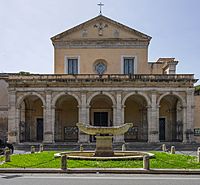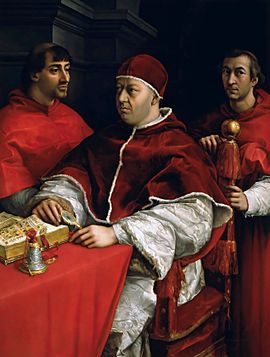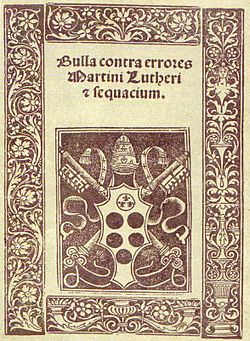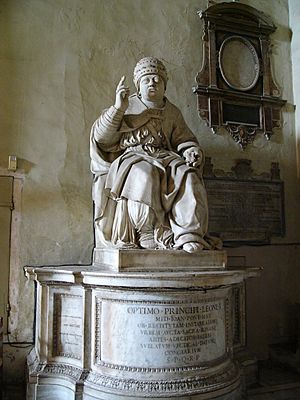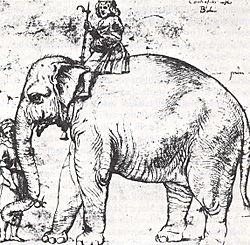Pope Leo X facts for kids
Quick facts for kids Pope Leo X |
|
|---|---|
| Bishop of Rome | |

A painting of Pope Leo X by Raphael
|
|
| Church | Catholic Church |
| Papacy began | 9 March 1513 |
| Papacy ended | 1 December 1521 |
| Predecessor | Julius II |
| Successor | Adrian VI |
| Orders | |
| Ordination | 15 March 1513 |
| Consecration | 17 March 1513 by Raffaele Sansone Riario |
| Created Cardinal |
|
| Personal details | |
| Birth name | Giovanni di Lorenzo de' Medici |
| Born | 11 December 1475 Florence, Republic of Florence |
| Died | 1 December 1521 (aged 45) Rome, Papal States |
| Buried | Santa Maria sopra Minerva, Rome |
| Previous post |
|
| Signature |  |
| Coat of arms | |
| Other Popes named Leo | |
| Papal styles of Pope Leo X |
|
|---|---|
 |
|
| Reference style | His Holiness |
| Spoken style | Your Holiness |
| Religious style | Holy Father |
| Posthumous style | None |
Pope Leo X (born Giovanni di Lorenzo de' Medici) was the leader of the Catholic Church and the ruler of the Papal States. He served from March 9, 1513, until his death in December 1521.
Giovanni was born on December 11, 1475, into the powerful Medici family in Florence. This family was famous for its political influence and banking business. He was the second son of Lorenzo de' Medici, who ruled the Florentine Republic. Giovanni became a cardinal in 1489.
After Pope Julius II died, Giovanni was chosen as pope. He got support from the younger cardinals. Early in his time as pope, he finished the Fifth Council of the Lateran, which was a big meeting of church leaders. However, he found it hard to make the agreed-upon changes happen. In 1517, he fought a costly war to make his nephew, Lorenzo de' Medici, Duke of Urbino, the Duke of Urbino. This war used up a lot of the church's money.
Pope Leo X is also known for his actions during the start of the Protestant Reformation. He allowed the sale of indulgences to help pay for the rebuilding of St. Peter's Basilica. This practice was strongly criticized by Martin Luther in his 95 Theses. Leo X did not agree with Luther's ideas. In 1520, he issued a special order called Exsurge Domine, which condemned Luther's views. This made it very difficult for them to communicate.
Leo X loved art and spent a lot of money on it. During his time, work continued on St. Peter's Basilica. Artists like Raphael decorated rooms in the Vatican. Leo also improved the Roman University and encouraged the study of books, poems, and old artifacts. He died in 1521 and is buried in Santa Maria sopra Minerva, Rome. He was the last pope who was not a priest when he was elected.
Contents
Early Life and Education
Giovanni di Lorenzo de' Medici was born on December 11, 1475. His birthplace was Florence. He was the second son of Lorenzo the Magnificent and Clarice Orsini. Lorenzo was the powerful ruler of Florence.
From a young age, Giovanni was expected to have a career in the church. He received his first church haircut (tonsure) at age seven. Soon after, he was given many valuable church positions and benefits.
His father, Lorenzo, was concerned about Giovanni's character. He wrote a letter to warn him about avoiding bad habits and luxury. Lorenzo advised him to wake up early. He said this would help with his health and daily tasks.
Becoming a Cardinal
Giovanni's father convinced Pope Innocent VIII to make him a cardinal. This happened on March 8, 1488, when Giovanni was only 13 years old. However, he was not allowed to wear the cardinal's symbols or join in church meetings until three years later.
During this time, he received a great education at his father's humanistic court. He learned from famous thinkers like Angelo Poliziano and Pico della Mirandola. From 1489 to 1491, he studied theology and canon law at Pisa.
On March 23, 1492, Giovanni officially became a member of the Sacred College of Cardinals. He moved to Rome. His father sent him a letter with more advice. Lorenzo died soon after, on April 8. This brought 16-year-old Giovanni back to Florence for a short time.
He returned to Rome for the election of a new pope after Innocent VIII died. Giovanni tried to stop Cardinal Borgia from being elected, but he was not successful.
Giovanni then lived with his older brother Piero in Florence. This was during a time of unrest caused by Girolamo Savonarola. The Medici family was forced out of Florence in November 1494. Giovanni traveled through Germany, the Netherlands, and France.
In May 1500, he came back to Rome. Pope Alexander VI welcomed him kindly. Giovanni spent several years focused on art and literature. In 1503, he was happy when Pope Julius II became pope. When his brother Piero died that same year, Giovanni became the head of his family.
In 1511, he was made a special representative (papal legate) for Bologna and Romagna. When Florence supported a group that disagreed with the pope, Julius II sent Giovanni with the papal army against the French. The French won a big battle and captured Giovanni. Later, the Medici family was able to return to power in Florence. Giovanni's younger brother Giuliano was put in charge, but Giovanni really managed the government.
Becoming Pope
Papal Election
Giovanni was chosen as pope on March 9, 1513. This was announced two days later. The French cardinals were not there, so the election was mainly between Giovanni and Raffaele Riario. Giovanni had the support of the younger cardinals.
On March 15, 1513, he became a priest. Two days later, on March 17, he was made a bishop. He was crowned Pope on March 19, 1513, when he was 37 years old. He was the last person elected pope who was not already a priest.
War and Politics
Pope Leo X wanted his younger brother Giuliano and his nephew Lorenzo to have important non-religious careers. He put Lorenzo in charge of Florence. He wanted to create a kingdom in central Italy for Giuliano.
When Giuliano died in March 1516, Leo focused his plans on Lorenzo. Leo joined a group of countries including Spain and England against France. He even got money from King Henry VIII of England for this.
The war lasted from February to September 1517. It ended with Lorenzo becoming the Duke of Urbino. However, this war was very expensive. It cost Leo about 800,000 ducats. It also caused more crime and disorder in the Papal States.
Leo also faced problems with some cardinals. He believed some were plotting to poison him. He punished one cardinal by executing him and imprisoned others. He then appointed 31 new cardinals on July 3, 1517. This was a very large number for the time. Some appointments were for political reasons or to raise money for the war.
Leo was worried about the Ottoman sultan, Selim I, who was threatening eastern Europe. He made plans for a crusade, a holy war. He wanted a truce across all Christian lands. The pope would settle disagreements. The emperor and the king of France would lead the army. England, Spain, and Portugal would provide the navy. All forces would attack Constantinople.
However, his efforts for peace failed. Much of the money collected for the crusade was used for other things. In 1519, Hungary made a truce with Selim I. But the next sultan, Suleiman the Magnificent, started the war again in June 1521. He captured Belgrade. Leo was very concerned and sent money to the Hungarians.
The Protestant Reformation
Leo X's time as pope was greatly affected by the Protestant Reformation, which was started by Martin Luther.
In 1517, Martin Luther wrote his Ninety-five Theses about indulgences. This was in response to concerns about how some people were selling them. Luther's ideas quickly spread across Germany and Europe. At first, Leo did not fully understand how important this movement was.
In February 1518, Leo told the Augustinian order to silence Luther. On May 24, Luther sent an explanation of his ideas to the pope. On August 7, he was told to come to Rome. However, an agreement was made for Luther to meet with Cardinal Cajetan in Augsburg in October 1518 instead. But Luther refused to change his mind.
A year of talks followed, but they did not work. The disagreement grew popular across Germany. On June 15, 1520, Leo issued another papal order, Exsurge Domine. This order condemned 41 of Luther's teachings. On January 3, 1521, Leo officially removed Luther from the church (excommunicated him) with the order Decet Romanum Pontificem. The Pope also told Charles V, Holy Roman Emperor to take strong action against Luther's ideas.
During Leo's time, Lutheranism also spread into Scandinavia. The pope had often given church benefits in the north to people in Rome. In 1516, he sent a representative to Denmark to collect money for St. Peter's. This led to problems and helped start the Reformation in Denmark.
Other Important Actions
New Cardinals
Pope Leo X appointed 42 new cardinals during his time. This included two of his cousins and a nephew. One of the new cardinals, Adriaan Florensz Boeyens, later became Pope Adrian VI, Leo's successor. On July 1, 1517, Leo created 31 cardinals at once. This was the largest number of cardinals created in one day until Pope John Paul II named 42 in 2001.
Making Saints
Pope Leo X made eleven people saints during his rule. Seven of these were a group of martyrs. The most famous person he made a saint was Francis of Paola on May 1, 1519.
Final Years and Death
Leo's focus on Italian politics and the Medici family partly explains why he did not do more to stop the anti-papal movement in Germany. The death of Emperor Maximilian in 1519 changed the political situation. Leo struggled to decide which powerful candidate to support as the next emperor. He eventually accepted Charles of Spain.
Leo wanted to add Ferrara, Parma, and Piacenza to the Papal States. In May 1521, he signed an agreement with the emperor. They planned to take Milan and Genoa from France. Parma and Piacenza would go to the Church. Leo agreed to make Charles V the King of Naples and Holy Roman Emperor. He also promised to help in a war against Venice.
Leo X became sick with bronchopneumonia and died suddenly on December 1, 1521. He was 45 years old. He died so quickly that he could not receive the last rites. People at the time suspected he was poisoned, but this was not true. He was buried in Santa Maria sopra Minerva in Rome.
Pope Leo X: His Character and Interests
Overall View
People have criticized Leo X for how he handled events during his time as pope. He had a pleasant voice and a cheerful personality. He was good at speaking and writing. He loved music, theater, art, and poetry. He enjoyed old masterpieces and new creations, especially those with humor and knowledge. He was especially good at making up Latin poems on the spot.
Some say he once said, "Let us enjoy the papacy since God has given it to us." However, historians are not sure if he actually said this. Even if he didn't, it shows he enjoyed life and might have had a relaxed attitude toward his important role. But despite his love for worldly pleasures, Leo prayed, fasted, went to confession, and took part in church services. He was generous, kind, and forgiving. He also had qualities like cleverness and being good at tricking others, which were valued by leaders of his time.
In the past, some people accused Leo X of bad things like being immoral, a murderer, and not believing in God. These claims were later shown to be false by historians. However, even the famous philosopher David Hume said that Leo was too smart to believe in Catholic teachings. But Hume also called him "one of the most illustrious princes that ever sat on the papal throne." He described Leo as kind, generous, friendly, and a supporter of all arts and virtues.
Historian Barbara W. Tuchman also wrote about Leo X. She described him as a cultured person who loved pleasure, even though he was religious. She believed his actions helped cause the Protestant Reformation.
Love for Learning and Arts

Leo X's love for all kinds of art came from his education in Florence. He also studied in Pisa and traveled a lot when he was young. He enjoyed Latin poems, Greek tragedies, and comedies. He also loved hearing about the discoveries in the New World.
His interest in humanism was also religious. During the Renaissance, people saw classical ideas and Christian ideas as connected. Artists would show figures like Cupid and the Madonna side-by-side.
Love of Music
Leo X loved music very much, even from a young age. He had a good ear and a nice voice. As pope, he hired professional singers, musicians, and composers from places like France, Germany, and Spain. Musicians were paid very well and also received gifts from Leo. They were important for making church services more beautiful.
Leo cared a lot about the quality of the papal choir. He hired singers from different countries. He also spent a lot of money on fancy musical instruments. He worked hard to get musical scores from Florence. He also supported new ways to print music. For example, he gave Ottaviano Petrucci the special right to print organ music for 15 years. Leo also encouraged singing the Gospel in Greek in his private chapel.
Other Activities
Even those who defend Leo X admit he enjoyed entertainment. This included masquerades, jokes, hunting birds, and hunting wild animals. One writer said he was "engrossed in idle and selfish amusements."
Leo also allowed jesters (buffoons) at his court. He sometimes let them be made fun of. For example, there was a proud poet named Giacomo Baraballo. Leo organized a funny parade for him, like an ancient Roman victory parade. Baraballo was dressed in fancy clothes and presented to the pope. Then he rode on Hanno, a white elephant given by King Manuel I of Portugal. The elephant was beautifully decorated. It was led toward the Capitol with drums and trumpets. But as they crossed the bridge of Sant'Angelo over the Tiber, the elephant got scared by the noise. It threw Baraballo into the muddy riverbank.
Generosity
Pope Leo X gave more than 6,000 ducats each year to help others. This money went to retirement homes, hospitals, convents, soldiers who had left the army, pilgrims, poor students, exiles, disabled people, and the sick.
Legacy and Impact
Failure to Stop the Reformation
Perhaps the most lasting impact of Pope Leo X's time was his failure to stop the Reformation. Some believe he even helped it grow. A key problem was that he did not put into practice the changes decided at the Fifth Council of the Lateran. This council aimed to fix political problems and reform the church. Many believe these changes might have reduced support for radical challenges to church authority.
Instead, under Leo's leadership, the church's money problems got worse. A major reason was his lavish spending on arts and himself. This led the church into deep debt. His decision to allow the sale of indulgences also contributed. The way indulgences were sold, and the corruption linked to it, quickly became a main reason for the start of the Protestant Reformation. Martin Luther's 95 Theses was posted in Germany in October 1517. This was just seven months after the Lateran V council finished. Leo X tried to stop Luther's teachings and later excommunicated him in January 1521. But this did not get rid of Luther's ideas. Instead, it caused the Western church to split even further.
Excessive Spending
Leo was famous for spending a lot of money. He spent it on arts, charities, and gifts for his friends and family. He also spent on wars, like the War of Urbino, and on his own luxurious lifestyle. Within two years of becoming pope, Leo X had spent all the money saved by the previous pope, Julius II. He put the Papacy deeply into debt. By the end of his time as pope in 1521, the church owed 400,000 ducats.
This debt caused problems during Leo's own time, especially the sale of indulgences that led to Protestantism. It also caused severe problems for later popes. To get money, Leo had his cousin, Cardinal Giulio de' Medici, pawn church jewels, furniture, tableware, and even statues of the apostles. Leo also sold positions as cardinals. He even created a new group called the Papal Knights of St. Peter and St. Paul in 1520 and sold memberships. He borrowed so much money from bankers that many of them were ruined when he died.
Supporter of Learning
Leo X made the Church a great supporter of knowledge and culture. He made Rome, the capital of Christendom, a center of European culture. Even as a cardinal, he had helped restore a church with designs by Raphael. As pope, he had new churches built and pushed forward work on St. Peter's Basilica and the Vatican.
Leo also improved the Roman university, which had been neglected. He brought back all its study areas, paid professors more, and invited famous teachers from far away. He invited Janus Lascaris to Rome to teach Greek. He also set up a Greek printing press. The first Greek book printed in Rome came out in 1515.
He made Raphael the caretaker of old Roman artifacts. The ancient monuments were the subject of a famous letter from Raphael to the pope in 1519. Famous Latin writers like Pietro Bembo and Jacopo Sadoleto worked as papal secretaries. Many other poets and writers of the time also worked for the pope.
Statesman
Several other important things happened during Leo's time as pope. He was very friendly with King Manuel I of Portugal. This was because of the king's efforts to spread Christianity in Asia and Africa. King Manuel I sent a large group of representatives to Pope Leo X with gifts from his colonies.
His agreement with Florence (1516) allowed the clergy in that city to be freely elected. In 1519, he condemned the King of Spain's claim to refuse the publication of papal orders. He kept close ties with Poland because of the Turkish advance and Poland's fight with the Teutonic Knights.
Leo showed special kindness to the Jews. He allowed them to set up a Hebrew printing press in Rome. This press produced important Jewish texts with Leo's approval. He also approved the creation of the Oratory of Divine Love, a group of religious men that later became the Theatine Order.
Images for kids
See also
 In Spanish: León X para niños
In Spanish: León X para niños


